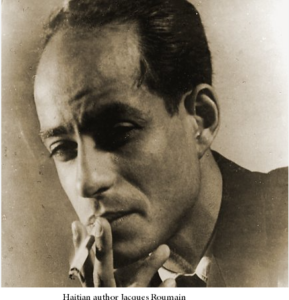By Marc-Antoine Dusset
Special to CSMS Magazine
This article was submitted to CSMS Magazine by a devoted reader with a deep passion for Caribbean literature. The author writes under a pen name to avoid unwarranted criticism. We are truly honored by the recognition given to Ardain Isma, our magazine editor. However, it is essential to acknowledge that Jacques Roumain remains one of the most influential and ideologically driven Haitian writers of the 20th century. Gouverneurs de la Rosée, his most renowned work, is not only a cornerstone of Haitian literature but also a timeless gift to humanity.
As the author of this critique aptly observes, “Both novels use nature as a central symbol, but their meanings differ in significant ways.”
Nevertheless, the fact that readers have embraced Midnight at Noon as a meaningful and cherished literary work is a profound encouragement. It serves as a powerful affirmation of Ardain’s unwavering commitment to social justice through literature, inspiring him to continue his journey with even greater resolve.
____________________________________________________________________
For decades, Jacques Roumain’s Gouverneurs de la Rosée has stood as a cornerstone of Haitian literature, celebrated for its poignant portrayal of land struggles, community divisions, and peasant resilience. More recently, Ardain Isma’s Midnight at Noon has entered the literary landscape, prompting discussions among readers who have noted striking similarities between the two works. But while these novels share common themes of rural hardship, resistance, and hope, they ultimately chart distinct paths through Haiti’s historical and political terrain.
Shared Themes: Peasant Struggles and the Fight for Justice
Both Gouverneurs de la Rosée and Midnight at Noon are deeply rooted in the Haitian countryside, where poverty and injustice shape the lives of their protagonists. In both stories, the authors present a young peasant protagonist who seeks change amid the constraints of an oppressive system.
In Gouverneurs de la Rosée, Manuel, a young Haitian migrant, returns from Cuba to his drought-stricken village with a vision of unity and restoration. He believes that only through collective action can his people overcome division and reclaim their land. Similarly, in Midnight at Noon, Odilon, a young peasant, is propelled into political resistance after the wrongful execution of his brother, leading him to challenge the very forces of dictatorship and repression that seek to control his people.
While both protagonists seek justice, the mechanisms through which they attempt to achieve it differ drastically. Manuel’s vision is rooted in reconciliation and agricultural renewal, emphasizing a philosophy of collective progress. He embodies the idealistic belief that if people come together, they can overcome even the harshest adversities. Odilon, on the other hand, has no such luxury. His world is not simply one of internal strife but of a direct and violent power struggle against a ruthless regime. Where Manuel turns inward toward his community to rebuild, Odilon is forced outward, grappling with the crushing weight of a dictatorial system that leaves little room for negotiation or hope.
Key Differences: Political Struggles vs. Agricultural Revival
Despite their shared themes, the novels differ significantly in scope and narrative focus.
 Roumain’s Gouverneurs de la Rosée is not explicitly political in the sense of state oppression; rather, it is a social critique that examines land as a source of survival, identity, and unity. Manuel’s battle is not against a government but against division among his own people, and his tragic end serves as a lesson in perseverance and hope.
Roumain’s Gouverneurs de la Rosée is not explicitly political in the sense of state oppression; rather, it is a social critique that examines land as a source of survival, identity, and unity. Manuel’s battle is not against a government but against division among his own people, and his tragic end serves as a lesson in perseverance and hope.
Conversely, Midnight at Noon is inherently political, set against the backdrop of dictatorship and authoritarian control. Odilon’s struggle is not simply for land or unity but for survival and freedom in the face of tyranny. Unlike Manuel, who seeks reconciliation, Odilon is thrust into defiance, facing state brutality and revolutionary fervor.
In addition, Midnight at Noon presents a more immediate and visceral confrontation with power, depicting not just the struggles of the peasantry but also the wider machinations of political control and repression. The novel does not merely observe the plight of the oppressed—it plunges its protagonist into the direct line of fire, forcing him to reckon with not only the injustices of his world but the personal cost of resistance.
The Role of Nature and Symbolism
Both novels use nature as a central symbol, but their meanings differ in significant ways. In Gouverneurs de la Rosée, the search for water and fertile land is both a literal and metaphorical journey, symbolizing hope, renewal, and the potential for collective growth. Manuel’s quest is one of reconciliation—uniting a fragmented community in the shared goal of survival.
 In Midnight at Noon, nature takes on a darker, more foreboding role. The landscape serves not only as a backdrop but as an embodiment of harsh realities and unrelenting oppression. While lush and fertile, it is also hostile, unforgiving, and filled with unseen dangers. The mountains and valleys that Odilon traverses mirror his own internal struggles—his journey is not one toward unity but toward resistance and, ultimately, revolution.
In Midnight at Noon, nature takes on a darker, more foreboding role. The landscape serves not only as a backdrop but as an embodiment of harsh realities and unrelenting oppression. While lush and fertile, it is also hostile, unforgiving, and filled with unseen dangers. The mountains and valleys that Odilon traverses mirror his own internal struggles—his journey is not one toward unity but toward resistance and, ultimately, revolution.
A Common Literary Legacy: Haiti’s Enduring Fight for Justice
While Roumain’s work belongs to an era of rural struggles and poetic optimism, Isma’s novel reflects the harsher realities of political oppression and radical change.
Both books, however, contribute to a shared literary legacy of Haitian resistance, revealing that, whether through land reclamation or political rebellion, the Haitian peasantry has always been at the heart of the nation’s fight for justice.
Moreover, these novels remind us that Haiti’s struggles are not confined to history. The themes explored—exploitation, resilience, political control, and the power of collective action—continue to define the nation’s reality.
For readers interested in historical fiction that explores Haitian resilience, class struggles, and the tension between oppression and hope, both Gouverneurs de la Rosée and Midnight at Noon are essential reads. While their protagonists take different paths, their stories remind us that resistance comes in many forms—and that the fight for justice is timeless.
Final Thought: Two Stories, One Unbreakable Spirit
At their core, Gouverneurs de la Rosée and Midnight at Noon tell two sides of the same story—one of hope through unity and one of revolution through necessity. These novels stand as testaments to Haiti’s complex, painful, yet unyielding spirit, proving that whether through community or conflict, the fight for dignity and justice will never be silenced.
Note: To order a copy of Midnight at Noon, you can click here.
Gouverneurs de la Rosée is translated into many languages. To order a copy of the English version (Masters of the Dew), you can click here.



Thank you for acknowledging this. It is because of readers like you that we have the courage and devotion necessary to keep on writing. Once again, thank you!
What a striking article! I am fascinated how Dusset casts the literary arc from Roumain to Isma. We see how Caribbean literature has developed and grown. As with Roumain’s Masters of the Dew, Midnight at Noon is destined to become a classic novel and will be read in literary classes around the world.
As always, CSMS is one of the best things about the cyberspace! A wonderful corner of the internet to read intriguing, beautiful and important things.